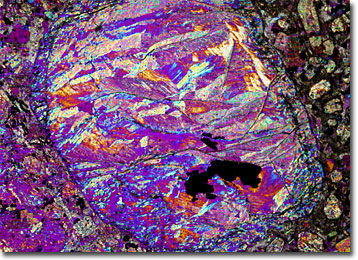Polarized Light Microscopy Digital Image Gallery
Lamproite
Lamproite is a type of igneous rock that has recently undergone a massive scientific reexamination, resulting in a comprehensive revision of its taxonomy, as well as related nomenclature. The impetus for this sudden, in-depth reassessment was the discovery of economically advantageous diamond-bearing varieties of the rock.

Once believed to be present only in kimberlite, in 1979 commercial-grade diamonds were found in a deposit of olivine lamproite in Western Australia. Six years later, production began at the Argyle diamond pipe, and the mine has since become the single greatest producer of carats per year. The vast majority of the diamonds extracted from the mine are utilized for industrial purposes, but approximately 5 percent are suitable for use as good quality gemstones. The discovery and profitability of the Argyle diamond pipe has prompted the examination of many other lamproite beds, including several found in the United States.
Lamproites, which typically contain olivine, diopside, leucite, sanidine, or richterite, are currently believed to originate from a partial melting in the lithospheric mantle at depths greater than 150 kilometers. When this magma is ejected to the surface of the planet, it picks up fragmented materials from the mantle and crust and carries them along in its current. Thus, it is when the magma travels through diamondiferous regions of the Earth that diamonds may become imbedded in the material. Kimberlite-based diamond deposits are believed to develop via similar means, although from magmas that derive from a different source.
